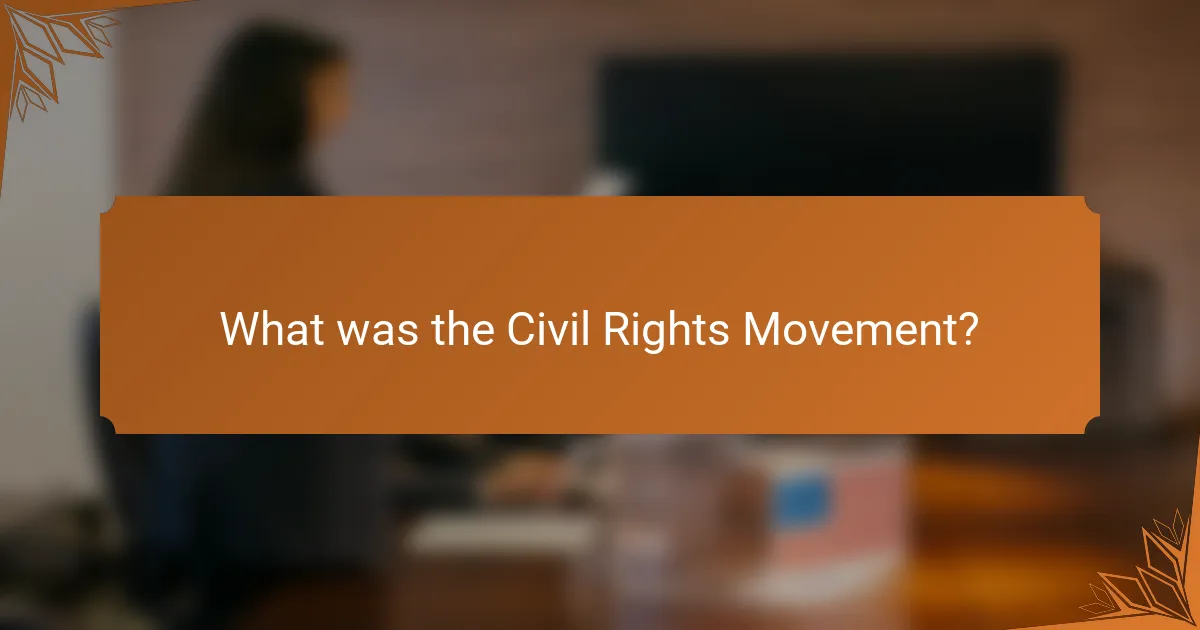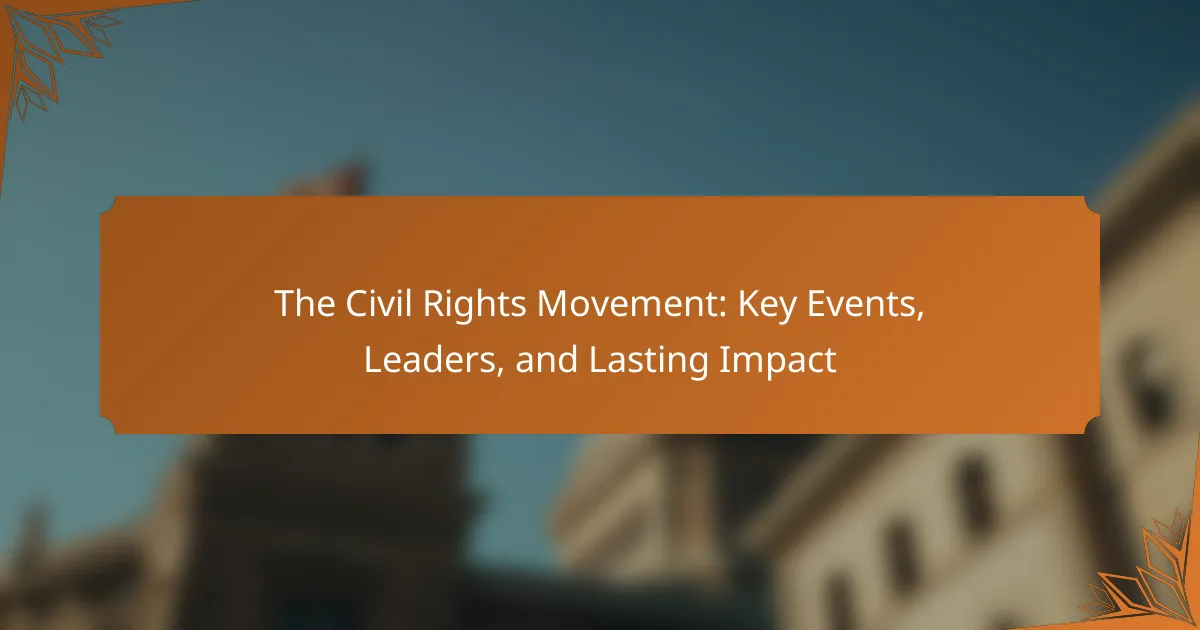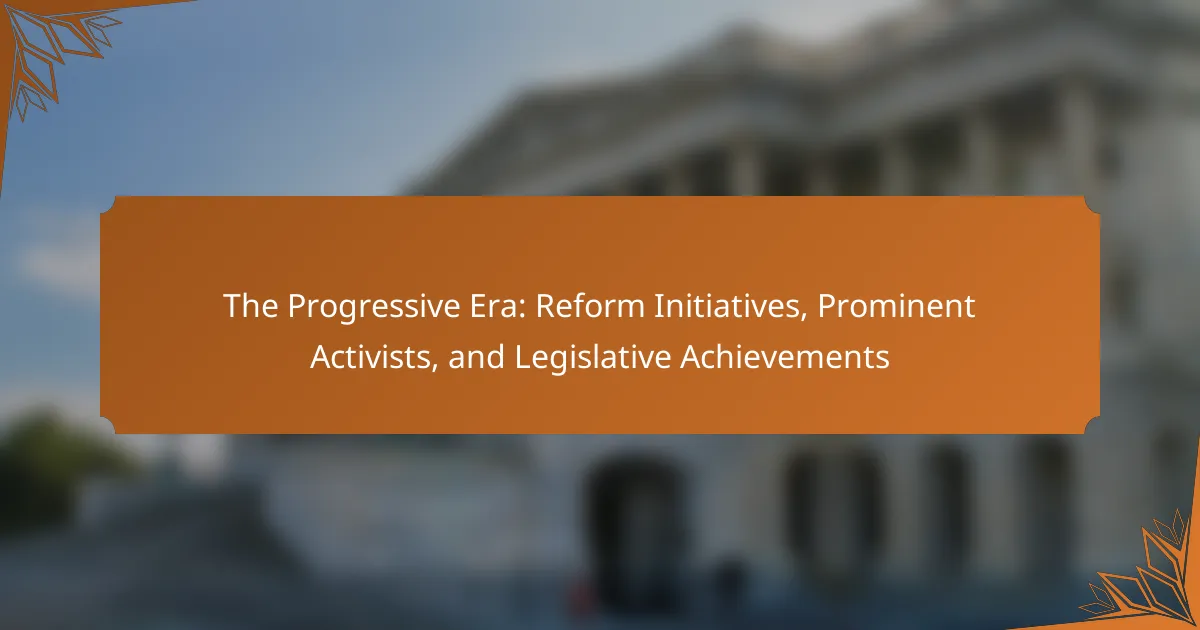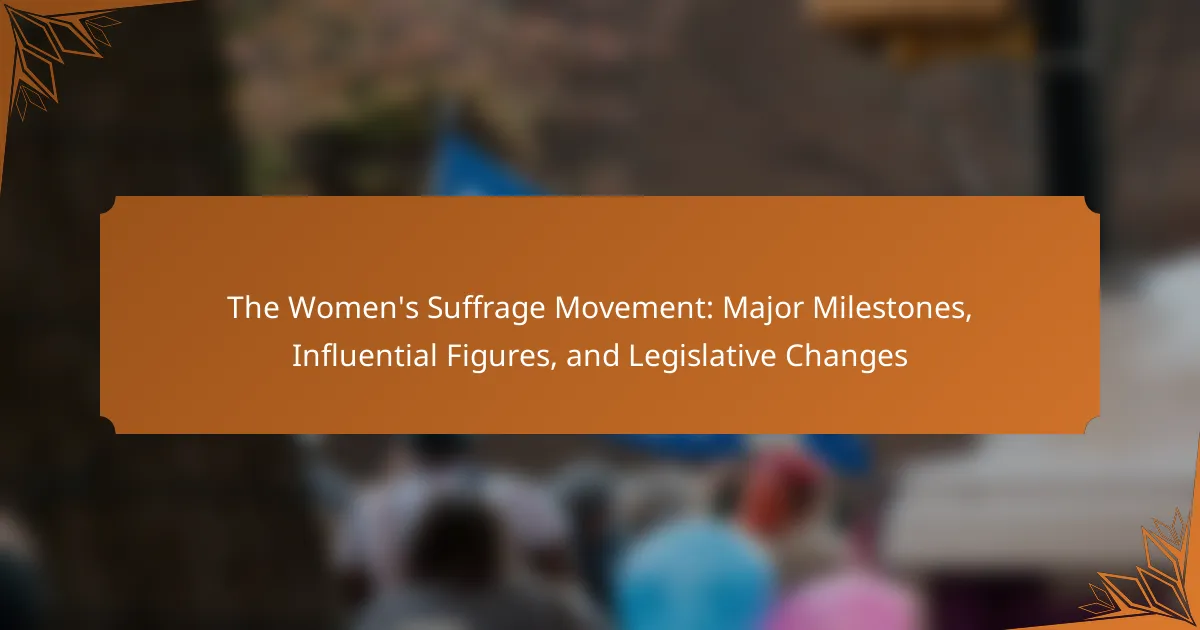The Civil Rights Movement was a pivotal social and political movement in the United States aimed at ending racial segregation and discrimination against African Americans, primarily occurring from the 1950s to the late 1960s. Key events include the Montgomery Bus Boycott of 1955 and the March on Washington in 1963, where Martin Luther King Jr. delivered his iconic “I Have a Dream” speech. The movement resulted in significant legislative achievements, including the Civil Rights Act of 1964 and the Voting Rights Act of 1965, which sought to eliminate voting barriers and guarantee equal rights. Influential leaders such as Rosa Parks, Malcolm X, and John Lewis played crucial roles in mobilizing millions and inspiring global social justice movements. The lasting impact of the Civil Rights Movement continues to shape contemporary discussions on race and equality in America.

What was the Civil Rights Movement?
The Civil Rights Movement was a social and political movement in the United States aimed at ending racial segregation and discrimination against African Americans. It primarily took place from the 1950s to the late 1960s. Key events included the Montgomery Bus Boycott in 1955 and the March on Washington in 1963, where Martin Luther King Jr. delivered his famous “I Have a Dream” speech. The movement led to significant legislative changes, such as the Civil Rights Act of 1964 and the Voting Rights Act of 1965. These laws aimed to eliminate barriers to voting and ensure equal rights for all citizens. The movement involved various leaders, including Rosa Parks, Malcolm X, and John Lewis. It mobilized millions of people and inspired other social justice movements globally. The Civil Rights Movement fundamentally reshaped American society and continues to influence contemporary discussions on race and equality.
How did the Civil Rights Movement begin?
The Civil Rights Movement began primarily in the 1950s as a response to racial segregation and discrimination against African Americans. Key events, such as the Montgomery Bus Boycott in 1955, sparked widespread activism. Rosa Parks’ refusal to give up her bus seat became a symbol of resistance. This event led to the formation of the Montgomery Improvement Association, led by Martin Luther King Jr. The movement gained momentum through organized protests, legal challenges, and grassroots activism. Landmark legislation, like the Civil Rights Act of 1964, resulted from these efforts, addressing systemic injustices. The movement’s influence continues to shape discussions on equality and civil rights today.
What were the social and political conditions leading to the Civil Rights Movement?
The social and political conditions leading to the Civil Rights Movement included widespread racial segregation and discrimination. Jim Crow laws enforced racial separation in the Southern United States. African Americans faced systemic disenfranchisement and were often denied the right to vote. Economic inequality was prevalent, with Black Americans having limited access to quality jobs and education. The Great Migration saw many African Americans move to urban areas, increasing awareness of civil rights issues. The post-World War II era brought heightened expectations for equality among returning Black veterans. The influence of organizations like the NAACP and grassroots activism contributed to the movement’s momentum. Key events, such as the Montgomery Bus Boycott in 1955, highlighted the demand for civil rights. These conditions collectively created an environment ripe for the Civil Rights Movement.
Who were the early influencers in the Civil Rights Movement?
Early influencers in the Civil Rights Movement included figures like W.E.B. Du Bois, Ida B. Wells, and A. Philip Randolph. W.E.B. Du Bois co-founded the NAACP in 1909 and advocated for civil rights through education and political action. Ida B. Wells was a prominent journalist who exposed lynching and fought for racial justice. A. Philip Randolph organized the first March on Washington in 1941, advocating for fair labor practices. These individuals laid the groundwork for the movement, influencing later leaders and strategies. Their contributions are integral to understanding the movement’s evolution.
What were the key events of the Civil Rights Movement?
The key events of the Civil Rights Movement include the Montgomery Bus Boycott, the March on Washington, and the Civil Rights Act of 1964. The Montgomery Bus Boycott began in 1955 after Rosa Parks refused to give up her seat. This boycott lasted for 381 days and led to a Supreme Court ruling against bus segregation. The March on Washington occurred in 1963, drawing over 250,000 participants. Martin Luther King Jr. delivered his famous “I Have a Dream” speech during this event. The Civil Rights Act of 1964 was signed into law, prohibiting discrimination based on race, color, religion, [censured], or national origin. Other significant events include the Freedom Rides in 1961 and the Selma to Montgomery marches in 1965, which highlighted voting rights issues. These events collectively advanced the cause of civil rights in the United States.
What major protests and demonstrations defined the Civil Rights Movement?
Major protests and demonstrations that defined the Civil Rights Movement include the Montgomery Bus Boycott, the March on Washington, and the Selma to Montgomery marches. The Montgomery Bus Boycott began in 1955 after Rosa Parks was arrested for refusing to give up her bus seat. This boycott lasted for 381 days and successfully ended racial segregation on public buses in Montgomery, Alabama. The March on Washington for Jobs and Freedom occurred in 1963, where Martin Luther King Jr. delivered his iconic “I Have a Dream” speech. This event drew over 250,000 participants and was pivotal in raising awareness for civil rights issues. The Selma to Montgomery marches in 1965 highlighted the struggle for voting rights. These marches faced violent opposition but ultimately led to the Voting Rights Act of 1965. Each of these events significantly advanced the cause of civil rights in the United States.
How did landmark legislation impact the Civil Rights Movement?
Landmark legislation significantly advanced the Civil Rights Movement. The Civil Rights Act of 1964 prohibited discrimination based on race, color, religion, [censured], or national origin. This legislation empowered activists by providing legal tools to challenge segregation and discrimination. The Voting Rights Act of 1965 eliminated barriers to voting for African Americans. These laws led to increased voter registration and participation in elections. Landmark legislation also fostered public awareness and support for civil rights issues. Overall, these laws were crucial in dismantling institutional racism in the United States.
Who were the prominent leaders of the Civil Rights Movement?
Prominent leaders of the Civil Rights Movement included Martin Luther King Jr., Rosa Parks, and Malcolm X. Martin Luther King Jr. advocated for nonviolent resistance and delivered the famous “I Have a Dream” speech in 1963. Rosa Parks is known for her pivotal role in the Montgomery Bus Boycott after refusing to give up her bus seat in 1955. Malcolm X emphasized black empowerment and was a key figure in the Nation of [censured]. Other notable leaders included John Lewis, who was instrumental in the Selma to Montgomery marches, and Ella Baker, who played a crucial role in organizing grassroots movements. These leaders collectively contributed to significant legislative changes, including the Civil Rights Act of 1964 and the Voting Rights Act of 1965.
What roles did Martin Luther King Jr. and Malcolm X play in the movement?
Martin Luther King Jr. played a pivotal role in the Civil Rights Movement as a leader advocating for nonviolent resistance. He emphasized peaceful protests, inspired by Mahatma Gandhi’s principles. His leadership during events like the Montgomery Bus Boycott in 1955 and the March on Washington in 1963 galvanized public support for civil rights legislation. King’s “I Have a Dream” speech highlighted the vision of racial equality and justice.
Malcolm X, on the other hand, represented a more militant approach to civil rights. He advocated for black empowerment and self-defense against oppression. His affiliation with the Nation of [censured] shaped his early views, promoting the idea of racial separation. However, after leaving the Nation, Malcolm X began to embrace a more inclusive perspective on human rights. His speeches and activism challenged systemic racism and urged African Americans to take pride in their heritage.
Both leaders significantly influenced the movement but differed in their strategies. King’s nonviolent approach sought integration and harmony, while Malcolm X’s philosophy emphasized strength and self-determination. Their contrasting methods enriched the dialogue surrounding civil rights and left a lasting impact on future generations.
How did lesser-known figures contribute to the Civil Rights Movement?
Lesser-known figures significantly contributed to the Civil Rights Movement through grassroots activism and local organizing. Many of these individuals helped mobilize communities for protests and boycotts. For instance, unsung leaders like Ella Baker emphasized the importance of collective action over individual leadership. Baker played a crucial role in founding the Student Nonviolent Coordinating Committee (SNCC) in 1960. Additionally, figures such as Fannie Lou Hamer advocated for voting rights and challenged systemic oppression. Hamer’s efforts led to the creation of the Mississippi Freedom Democratic Party in 1964. These contributions were vital in shaping the movement’s strategies and expanding its reach. Lesser-known activists often worked behind the scenes, organizing events and educating the public. Their dedication and efforts laid the groundwork for major legislative changes, including the Voting Rights Act of 1965.
What was the impact of the Civil Rights Movement on American society?
The Civil Rights Movement significantly transformed American society by advancing racial equality and social justice. It led to the end of legal segregation through landmark legislation such as the Civil Rights Act of 1964 and the Voting Rights Act of 1965. These laws prohibited discrimination based on race and ensured voting rights for African Americans. The movement also raised awareness of systemic racism and inspired other social justice movements. Activists like Martin Luther King Jr. and Rosa Parks became national symbols of the struggle for equality. The movement’s impact is evident in the ongoing fight for civil rights today, influencing policies and societal attitudes towards race.
How did the Civil Rights Movement shape modern civil rights legislation?
The Civil Rights Movement significantly influenced modern civil rights legislation. It led to the passage of landmark laws such as the Civil Rights Act of 1964. This act prohibited discrimination based on race, color, religion, [censured], or national origin. The movement also spurred the Voting Rights Act of 1965, which aimed to eliminate barriers to voting for African Americans. Activists organized protests, marches, and legal challenges that highlighted systemic injustices. These efforts raised public awareness and garnered political support for civil rights reforms. The movement’s legacy continues to shape discussions on equality and justice in legislation today.
What lasting changes did the Civil Rights Movement bring to social norms?
The Civil Rights Movement brought significant changes to social norms in the United States. It challenged and dismantled systemic racism and segregation. The movement led to the desegregation of public spaces, schools, and transportation. Laws like the Civil Rights Act of 1964 prohibited discrimination based on race, color, religion, [censured], or national origin. This legislation transformed societal expectations regarding equality and justice. Public attitudes shifted towards greater acceptance of diversity and inclusion. The movement also inspired other social justice movements, promoting activism for various marginalized groups. Overall, the Civil Rights Movement fundamentally reshaped American social norms towards equality and civil rights.
How does the legacy of the Civil Rights Movement continue today?
The legacy of the Civil Rights Movement continues today through ongoing advocacy for racial equality and social justice. Modern movements, such as Black Lives Matter, draw inspiration from the strategies and goals of the Civil Rights Movement. Legal reforms, including the Voting Rights Act, still influence contemporary legislation aimed at protecting minority rights. Educational initiatives promote awareness of civil rights history and its relevance. The movement’s emphasis on nonviolent protest remains a guiding principle for many activists. Public commemorations and memorials honor key figures and events from the era. The influence of Civil Rights leaders, like Martin Luther King Jr., persists in speeches and writings that inspire new generations. Overall, the foundational principles of the Civil Rights Movement continue to shape discussions on equity and justice in society.
What modern movements are influenced by the Civil Rights Movement?
Modern movements influenced by the Civil Rights Movement include Black Lives Matter, [censured] rights, and immigrant rights. Black Lives Matter emerged in response to systemic racism and police violence. It seeks to address inequalities faced by Black individuals. [censured] rights movements build on the foundation of civil rights activism. They advocate for equality and protection against discrimination. Immigrant rights movements draw parallels to the struggles for civil rights. They focus on the rights of undocumented immigrants and their contributions to society. These movements share the core principles of equality and justice established during the Civil Rights Movement.
How can individuals contribute to the ongoing fight for civil rights?
Individuals can contribute to the ongoing fight for civil rights by actively engaging in advocacy and education. They can participate in peaceful protests to raise awareness about civil rights issues. Volunteering for organizations that support civil rights can amplify their impact. Individuals can also educate themselves and others about the history and current state of civil rights. Supporting legislation that promotes equality is crucial. Donating to civil rights organizations helps fund their initiatives. Engaging in community discussions fosters dialogue on civil rights matters. Using social media platforms to spread awareness can reach a broader audience. Each action contributes to the larger movement for equality and justice.
What lessons can be learned from the Civil Rights Movement?
The Civil Rights Movement teaches the importance of perseverance in the face of adversity. Activists faced significant resistance yet continued their fight for equality. The movement demonstrated the power of collective action. Groups united to amplify their voices against injustice. Nonviolent protest proved effective in garnering public support. Events like the March on Washington highlighted the demand for change. Legal challenges led to landmark legislation, such as the Civil Rights Act of 1964. This illustrates the impact of strategic advocacy on policy reform. The movement also emphasized the significance of grassroots organizing. Local efforts were crucial in mobilizing communities for larger goals.
What strategies from the Civil Rights Movement can be applied to current social justice efforts?
Nonviolent protest is a key strategy from the Civil Rights Movement that can be applied to current social justice efforts. This approach emphasizes peaceful demonstrations to raise awareness and advocate for change. Historical examples include the Montgomery Bus Boycott and the March on Washington. These events mobilized large groups and drew national attention to civil rights issues. Grassroots organizing is another effective strategy. Community-based efforts can unite individuals around common goals, similar to how local chapters of organizations like the NAACP operated. Legal challenges were also pivotal during the Civil Rights Movement. Landmark cases like Brown v. Board of Education illustrate the importance of using the judicial system to fight discrimination. Coalition-building across diverse groups can amplify voices and strengthen movements. The Civil Rights Movement demonstrated that solidarity among various communities can lead to significant progress. Lastly, strategic use of media to highlight injustices played a crucial role. Televised events and news coverage helped to inform and engage the public. These strategies remain relevant in today’s social justice landscape.
How can understanding the Civil Rights Movement help in advocating for equality today?
Understanding the Civil Rights Movement provides essential insights for advocating equality today. The movement demonstrated the power of collective action and grassroots organizing. Leaders like Martin Luther King Jr. and Rosa Parks exemplified effective nonviolent resistance. Their strategies can inspire modern activists facing social injustices. Historical successes, such as the Civil Rights Act of 1964, show the impact of legislative change. Knowledge of these events can guide current efforts to address systemic racism. Additionally, understanding the movement’s challenges fosters resilience among advocates. By learning from past struggles, activists can develop informed approaches to contemporary issues.
The Civil Rights Movement was a pivotal social and political movement in the United States, primarily occurring from the 1950s to the late 1960s, aimed at ending racial segregation and discrimination against African Americans. Key events such as the Montgomery Bus Boycott and the March on Washington highlighted the struggle for equality, led by influential figures like Martin Luther King Jr. and Rosa Parks. Landmark legislation, including the Civil Rights Act of 1964 and the Voting Rights Act of 1965, emerged from this movement, significantly transforming American society and influencing ongoing discussions on race and equality today. The article will explore the movement’s origins, key events, prominent leaders, and its lasting impact on modern civil rights legislation and social norms.



